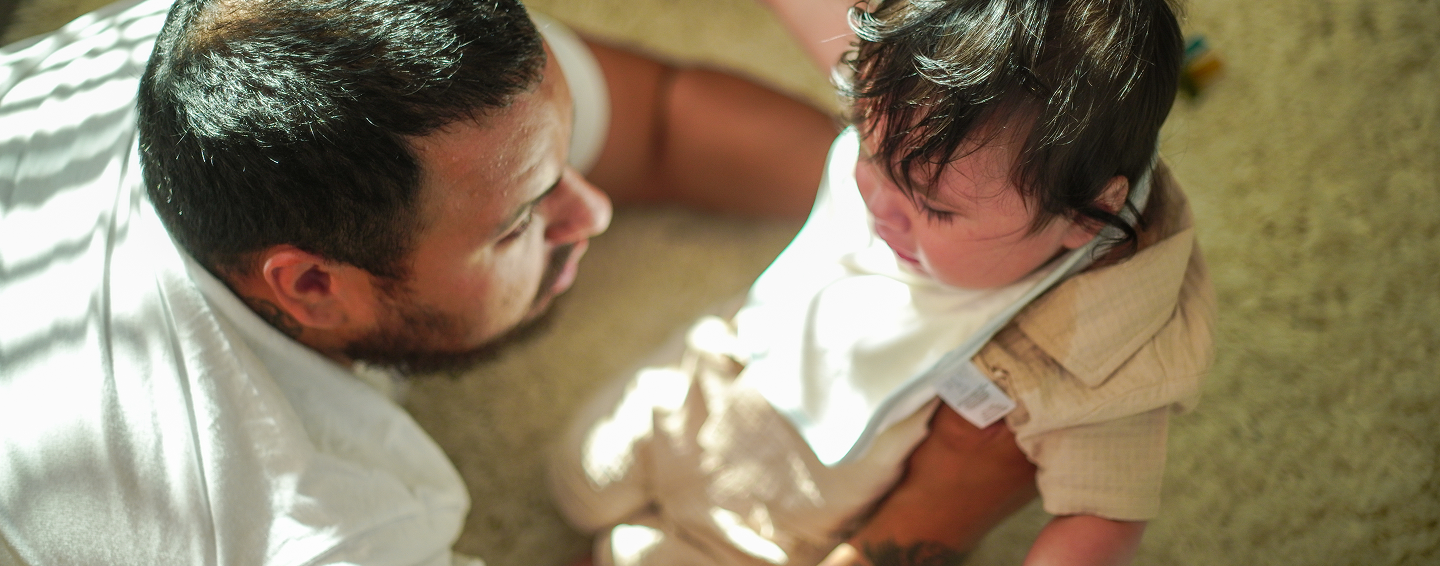Why Finding the Best Sleep Aid for Newborns Changes Everything
Best sleep aid for newborns can be the difference between 2-hour stretches and 5-hour blocks of rest for your entire family. When your baby sleeps better, you sleep better - and that means you can actually function during those precious early months.
Quick Answer - Top 5 Categories of Safe Sleep Aids:
- Swaddles & Sleep Sacks - Stop the startle reflex that wakes babies
- White/Brown Noise Machines - 80% of newborns fall asleep within 5 minutes
- Pacifiers - Reduce SIDS risk while providing comfort
- Environmental Helpers - Blackout curtains, breathable mattresses, optimal temperature
- Calming Touch Devices - Rhythmic patting, massage, gentle motion
Most newborns sleep about 18 hours per day but wake every 2-3 hours. By 3 months, many babies can sleep 7-8 hour stretches - if you have the right sleep aids and know how to use them safely.
The key is understanding that newborns spend half their sleep in REM (dream sleep), which is vital for brain development. They also have a strong startle reflex that can wake them constantly. Safe sleep aids work by mimicking the womb environment while following strict safety guidelines.
As someone who struggled with my own newborn's sleep challenges, I'm Gary Harutyunyan, and my personal experience led me to research and develop solutions that actually work for exhausted parents. My journey from sleepless nights to creating effective sleep aids has taught me which products truly deliver results versus those that just promise miracles.
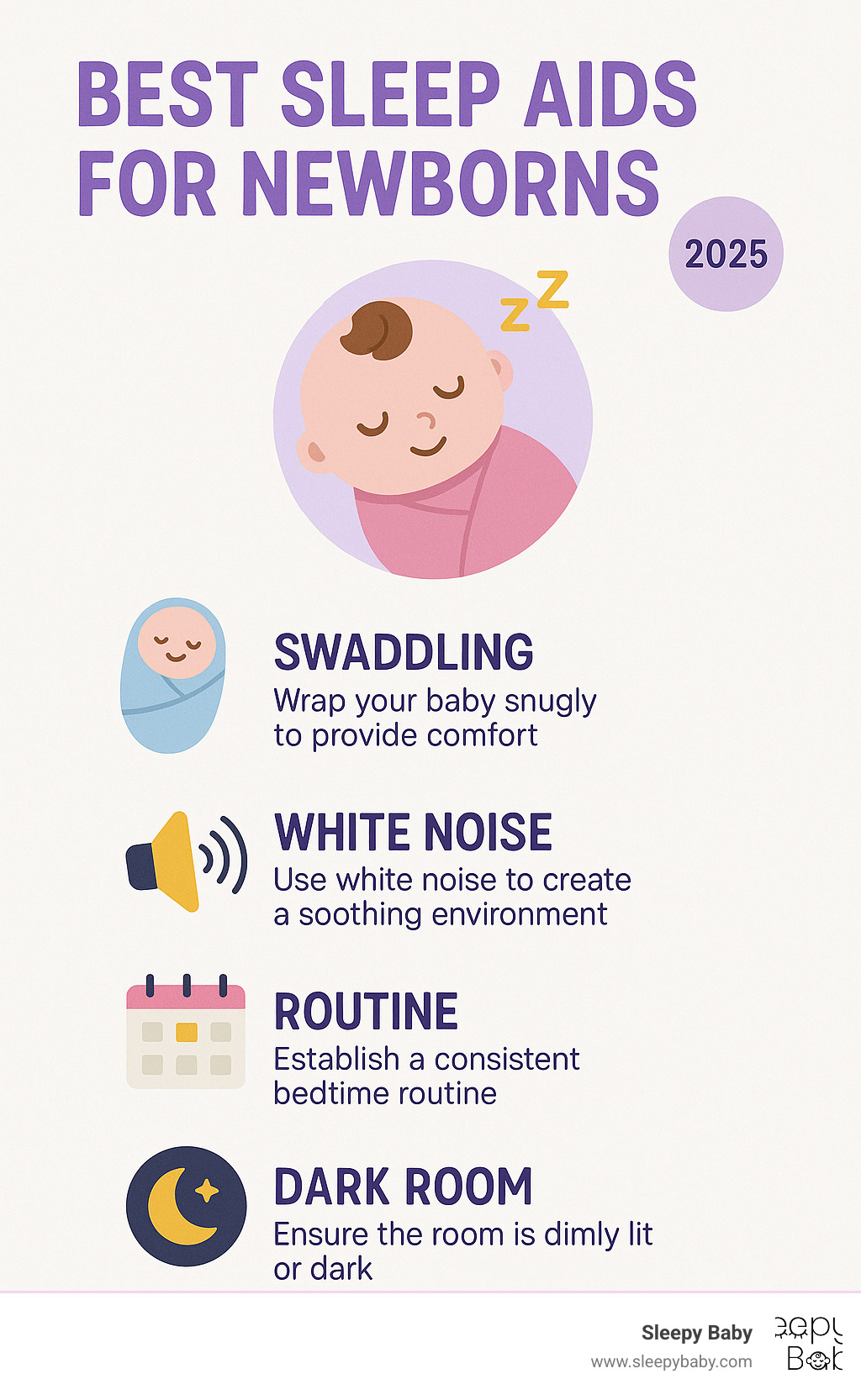
What Counts as a Newborn Sleep Aid & Is It Safe?
Think of a newborn sleep aid as anything that helps recreate the cozy, predictable environment your baby knew in the womb. These "sleep props" include swaddles that mimic the snug feeling of being tucked inside you, pacifiers that satisfy their natural sucking instinct, and white noise machines that replicate the whooshing sounds they heard for nine months.
The best sleep aid for newborns isn't necessarily the fanciest gadget - it's the one that works safely within established guidelines. When used correctly, most sleep aids aren't just safe - pediatricians actually recommend many of them.
Safety always comes first. The American Academy of Pediatrics' "back-to-sleep" campaign has reduced SIDS deaths by over 50% since the 1990s. Your baby should always sleep on their back until their first birthday, no exceptions.
Newborns are born with an incredibly jumpy startle reflex called the Moro reflex. Your peacefully sleeping baby suddenly throws their arms out like they're falling, jolting themselves awake. This happens because their nervous system is still developing during REM sleep, which makes up about half their sleep time.
Room-sharing for the first 6 months significantly reduces SIDS risk while making middle-of-the-night feedings easier. Your baby sleeps safely in their own crib or bassinet, close enough that you can hear every sound.
Temperature control is critical. Babies sleep best when their room stays between 16-20°C (60-68°F). Overheating increases SIDS risk, which is why breathable sleep sacks have replaced loose blankets.
For sound machines, safe decibel limits under 50 dB at your baby's ear level are non-negotiable. That's about as loud as a quiet conversation. Many devices can blast 85+ decibels - loud enough to damage tiny eardrums.
For swaddling, hip-healthy techniques mean keeping hips loose while snugging the arms. You'll need to stop swaddling once your baby shows signs of rolling, typically around 4-6 months.
Current Safety Guidelines at a Glance
The ABCs of safe sleep: Alone (no bed-sharing), on their Backs, in a safety-approved Crib.
Sound machines should remain below 50 dB and be placed at least 30 cm from your baby’s head. Newer tech options now offer gentle noise delivered close to the chest, but are engineered to stay within safe volume limits. Swaddling should allow free hip movement and be stopped as soon as your baby shows signs of rolling (typically 4-6 months). Pacifiers are safest in orthodontic shapes, never attached to strings—offer at sleep times, but don’t force use.
Keep your baby's crib completely bare until they're over 12 months old. No loose blankets, pillows, bumpers, or stuffed animals. Maintain that 16-20°C room temperature and dress your baby in light sleep clothing.
Best Sleep Aid for Newborns: 5 Science-Backed Categories
When you're desperate for sleep at 3 AM, it helps to know that science has your back. The most effective best sleep aid for newborns fall into five distinct categories, each targeting different aspects of how your baby's sleep system works.
| Category | How It Works | Age Range | Key Benefits | Main Cautions |
|---|---|---|---|---|
| Swaddles & Sleep Sacks | Suppresses startle reflex, mimics womb pressure | 0-6 months | Longer sleep stretches, fewer night wakings | Stop when rolling begins |
| White/Brown Noise | Masks environmental sounds, mimics womb acoustics | 0-12+ months | 80% fall asleep within 5 minutes | Keep volume <50dB, distance >30cm |
| Pacifiers | Satisfies sucking reflex, may reduce SIDS risk | 0-12 months | Self-soothing, SIDS protection | May fall out frequently |
| Environmental Controls | Optimizes sleep conditions (darkness, temperature) | 0+ months | Better sleep quality, longer stretches | None when used properly |
| Calming Touch/Motion | Activates parasympathetic nervous system | 0-6 months | Reduces crying, promotes deeper sleep | Avoid dependency on constant motion |
Swaddles & Transitional Sleep Sacks – Best Sleep Aid for Newborns' Moro Reflex
If you've ever watched your sleeping baby suddenly throw their arms up like they're catching themselves from falling, you've seen the Moro reflex in action. This startle response is normal - but it's why your little one keeps waking themselves up.
Swaddling is the gold standard for managing this reflex. When done correctly, it recreates that snug, secure feeling your baby had in the womb. Research shows that swaddled babies placed on their backs wake less often and spend more time in deep sleep phases.
Arms-in swaddling works beautifully for most newborns - their arms are snugly contained against their body. Some babies prefer arms-up swaddling, which lets them keep their hands near their face for self-soothing while preventing jarring arm movements.
The secret to safe swaddling: snug around the torso, loose around the hips. The fabric should be tight enough around the chest and arms to stop the startle reflex but loose enough around the hips to allow natural movement.
Breathable fabrics are non-negotiable. Cotton muslin and bamboo prevent overheating while wicking moisture.
Most babies need to transition out of swaddles between 4-6 months, when they start showing signs of rolling. Scientific research on swaddling and SIDS shows that swaddling becomes risky once babies can roll.
Transitional sleep sacks are lifesavers during this phase. These wearable blankets give your baby that cozy feeling without restricting their arms.
White/Brown Noise Machines – Best Sleep Aid for Newborns Who Startle Easily
80% of newborns fall asleep within 5 minutes when exposed to white noise, compared to only 25% without it. Your baby spent nine months surrounded by constant whooshing sounds from your blood flow and heartbeat - sounds that reached up to 95 decibels!
Brown noise often works even better than traditional white noise for newborns. It emphasizes deeper, rumbly frequencies that more closely match what babies heard in utero.
Timer settings offer 15, 30, or 45-minute options. This gives your baby enough soothing time to transition into deeper sleep without running all night.
Keep your sound machine at least 30 cm away from your baby's sleep area. Some devices can produce dangerous volume levels up close - 85+ decibels at 30 cm risks hearing damage.
The volume test is simple: stand next to the crib and have a normal conversation. If you need to raise your voice, the machine is too loud. You're aiming for under 50 decibels at your baby's ear level.
For detailed guidance, check out this Baby sound machine safety guide.
Pacifiers & Gentle Sucking Solutions
Pacifiers can reduce SIDS risk while satisfying your baby's natural sucking reflex. The American Academy of Pediatrics recommends offering them at sleep times, especially during the first six months when SIDS risk is highest.
The sucking motion activates your baby's parasympathetic nervous system - it flips the switch from "alert" to "calm." This non-nutritive sucking helps babies settle back down when they wake between sleep cycles.
Babies lose their pacifiers within 30 minutes of falling asleep about two-thirds of the time. Glow-in-the-dark handles help you find dropped pacifiers quickly and eventually help your baby learn to retrieve their own.
Orthodontic shapes support proper oral development. Most experts recommend weaning between 6-12 months to avoid speech development and dental problems.
Blackout & Environmental Helpers
Environmental optimization is often the best sleep aid for newborns who are sensitive to their surroundings.
Darkness triggers melatonin production - that natural sleep hormone your baby's body is learning to regulate. Even small amounts of light can disrupt this process.
Keep the room temperature between 16-20°C (60-68°F). Babies are more sensitive to temperature changes than adults, and overheating increases SIDS risk. A breathable crib mattress helps with temperature regulation.
Portable blackout tents work brilliantly for families who travel or have babies who need to nap in bright rooms. The best ones block up to 95% of ambient light.
Overnight-absorbent diapers can add hours to your baby's sleep stretches by preventing discomfort from wetness.
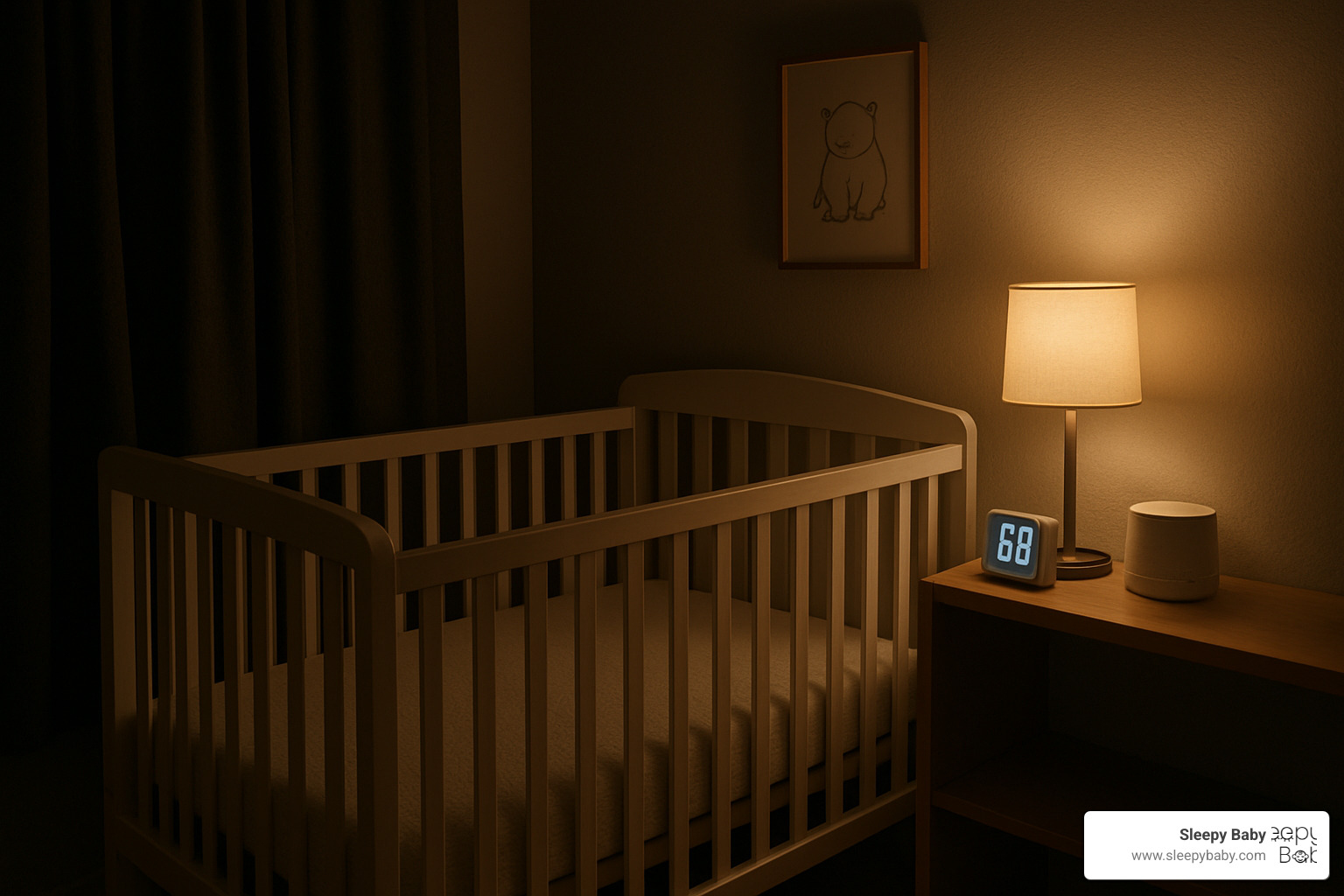
Calming Touch, Massage & Rhythmic Motion
Human touch is one of the most powerful sleep aids nature has given us. Babies who receive a gentle 15-minute massage each night experience fewer wake-ups and fall asleep more easily.
Kangaroo care (skin-to-skin contact) releases oxytocin in both you and your baby. This "love hormone" promotes bonding while reducing stress hormones that interfere with sleep.
Rhythmic patting devices provide consistent, gentle motion without requiring you to stand by the crib all night. These hands-free solutions let you step away while providing soothing sensation.
Gentle massage with lavender-scented lotion combines touch benefits with subtle aromatherapy. For babies with tummy discomfort, warm belly bands provide soothing heat that helps with gas and digestion issues.
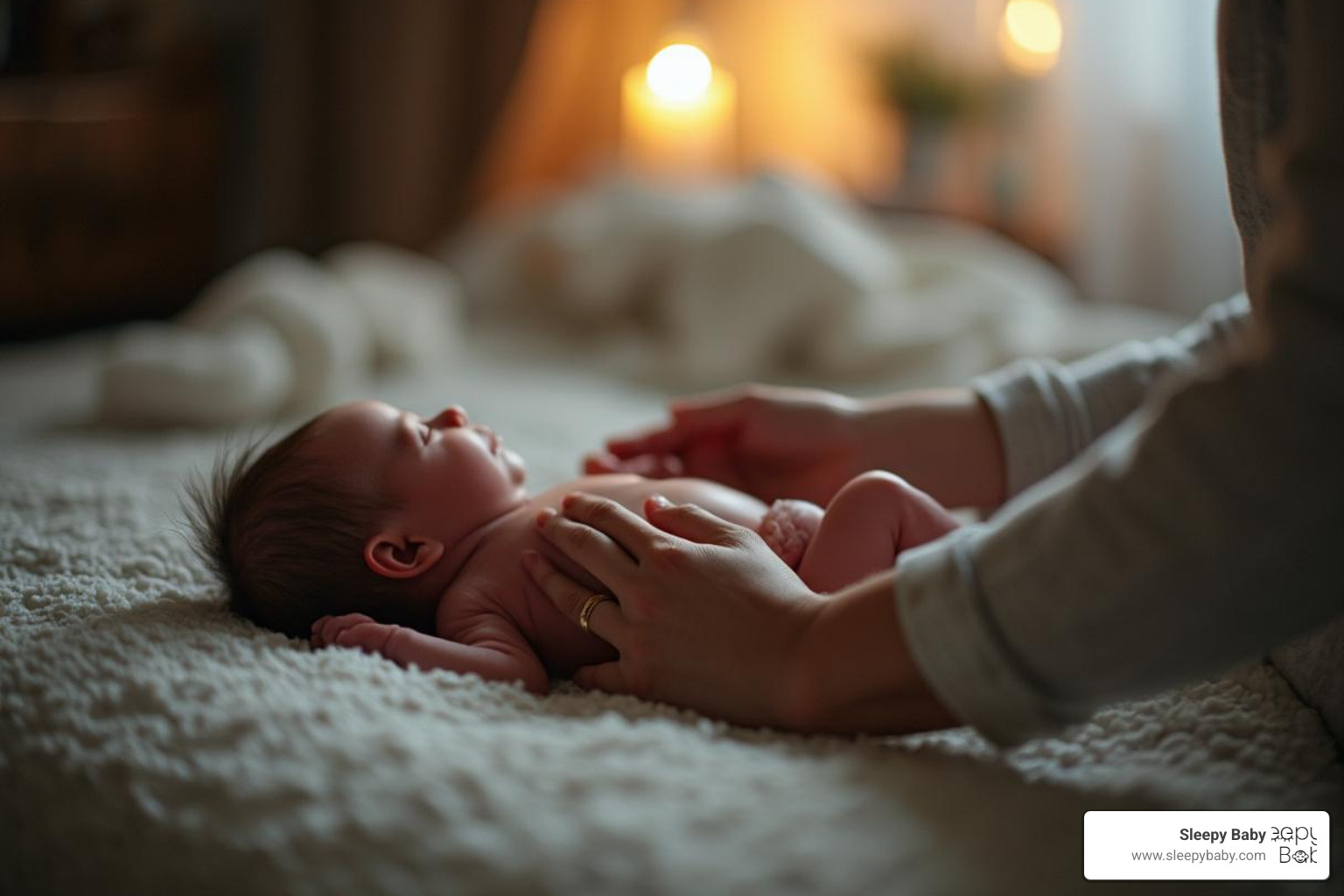
How & When to Use Each Aid Correctly
Getting the timing right with sleep aids can transform your baby's sleep patterns. The best sleep aid for newborns becomes truly effective when you understand the developmental windows that make each tool most helpful.
During the first 0-2 months, your newborn is still adjusting to life outside the womb. Start swaddling from day one if your baby seems startled awake frequently. White noise can begin immediately too. If breastfeeding, wait 2-3 weeks before introducing pacifiers to avoid nipple confusion.
The 2-4 month window is when sleep patterns start maturing. Continue with swaddling, but watch for any signs of rolling attempts. This is perfect timing to establish consistent bedtime routines and practice the "drowsy-but-awake" technique.
The drowsy-but-awake method means putting your baby down when they're sleepy but still have their eyes open. This teaches them that their crib is where sleep happens, not your arms.
Between 4-6 months, you'll hit the big transition period. Most babies start showing signs of rolling, which means swaddling becomes unsafe. Transitional sleep sacks become your best friend - they provide that cozy feeling without restricting arm movement.
Gradual elimination works much better than going cold turkey. If you want to wean your baby off a particular sleep prop, reduce its use slowly over one to two weeks.
For comprehensive guidance, explore Dreamland Awaits: Best Sleep Aids for Your Newborn.
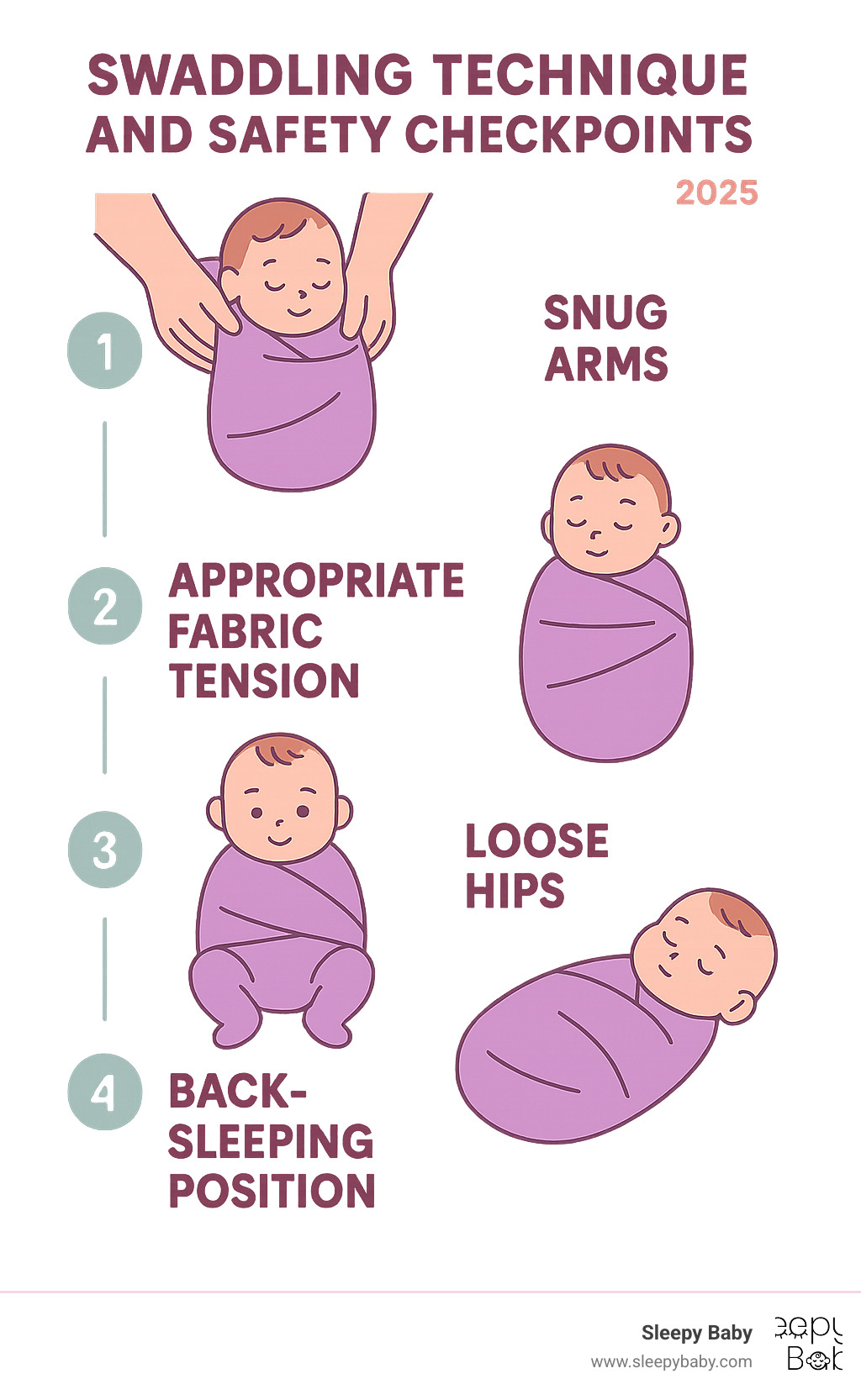
Step-by-Step Setup for the Best Sleep Aid for Newborns
Creating a consistent bedtime routine signals to your baby that sleep time is coming. This predictable sequence becomes incredibly powerful over time.
Start with a fresh diaper check - even if it doesn't feel heavy, changing it eliminates potential 2 AM wake-ups.
Next comes the swaddle or sleep sack, depending on your baby's age and rolling ability. Snug around the torso and arms, loose around the hips and legs.
Fire up that sound machine and set your timer for about 30 minutes. Position it at least arm's length away from the crib, keeping volume at conversation level.
Gradually dim the lights as you move through your routine. Red or amber bulbs won't interfere with melatonin production like blue or white light.
Offer the pacifier without forcing it. If your baby spits it out, that's perfectly fine.
The final step is placing your baby down while they're still awake. This helps babies develop independent sleep skills.
This entire routine should take about 10-15 minutes. Maintain consistency even when things don't go perfectly.
Building Long-Term Healthy Sleep Habits
Finding the best sleep aid for newborns is just the beginning. The real magic happens when you build sustainable sleep habits that grow with your baby.
Think of sleep aids as training wheels - they provide crucial support while your little one develops independent sleep skills. The goal isn't to use these tools forever, but to create a foundation for natural sleep development.
A consistent bedtime routine of 20 minutes works like a charm. This might include a warm bath, gentle massage with lotion, quiet story time, and final feeding. The key is doing roughly the same things in the same order each night.
Daytime light exposure plays a bigger role than most parents realize. Morning walks or sitting by a sunny window while feeding can help your baby's internal clock develop faster.
Learning to recognize feeding cues early changed everything for my family. When you respond to that first little whimper before full-blown crying begins, nighttime feedings become much easier. Your baby stays calmer and returns to sleep more quickly.
Every baby wakes up 4-6 times per night naturally - that's completely normal. Self-soothers figure out how to drift back to sleep on their own, while signalers need parental help. Quality sleep aids can help transform signalers into self-soothers over time.
Consistent wake times matter just as much as bedtimes. Try to start your day at roughly the same time, even on weekends. This helps regulate your baby's internal clock.
The hour before sleep should be your calm zone - avoid overstimulation before naps and bedtime. Keep voices soft and avoid exciting activities like peek-a-boo or bouncing games.
For comprehensive strategies, explore More info about baby sleep noise machines.
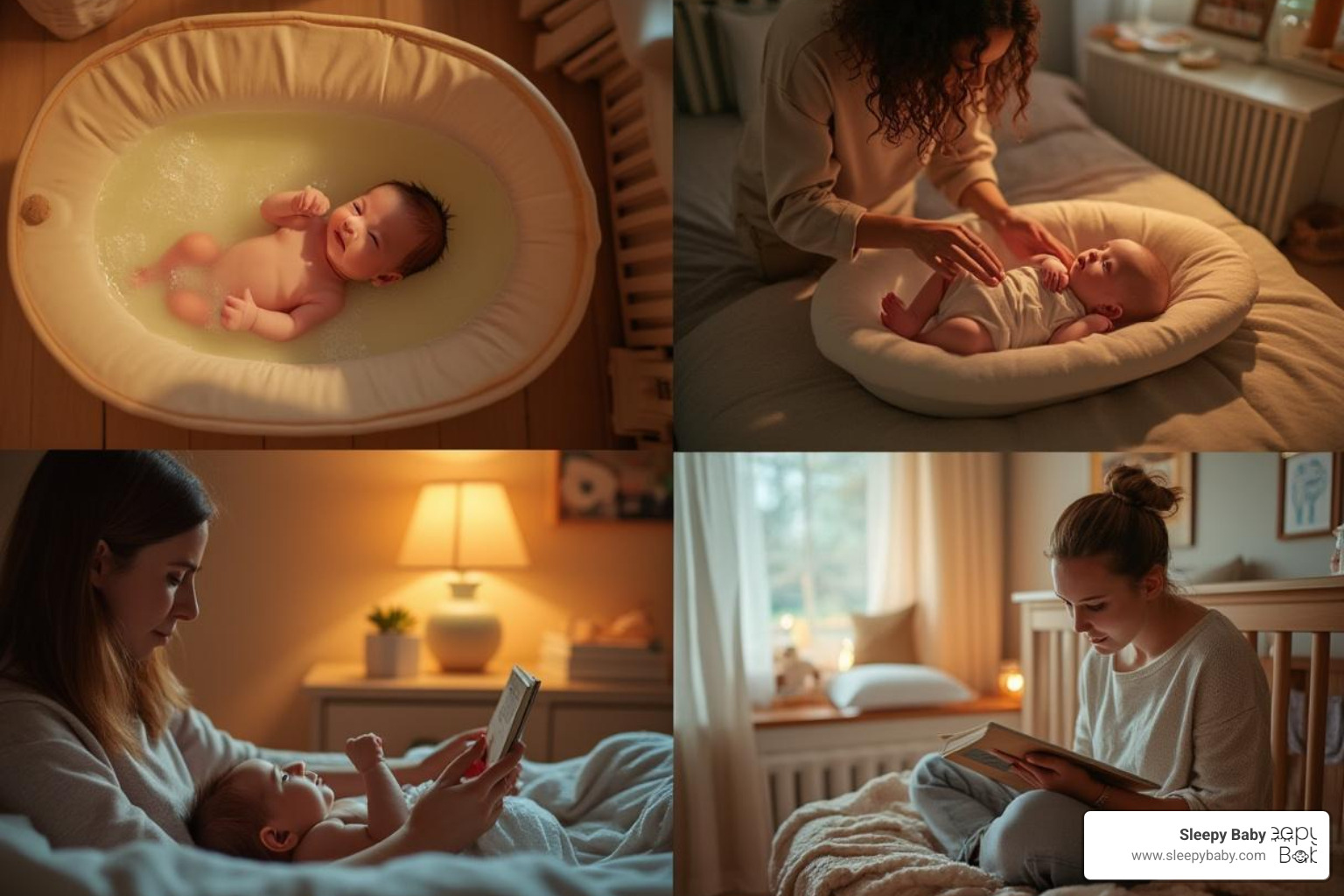
Frequently Asked Questions about Newborn Sleep Aids
When is it safe to stop swaddling?
The golden rule is simple: stop swaddling the moment your baby shows any signs of rolling. This usually happens between 4-6 months, but some babies start earlier.
Watch for these signs: your baby getting onto their side, showing increased strength during tummy time, or successfully rolling from back to front. Even if they've only rolled once, it's time to transition.
Start by swaddling with one arm out for a few nights, then move to both arms out before switching to a sleep sack completely. Don't worry if sleep gets bumpy during this transition - it's temporary.
How loud should a sound machine be?
Never exceed 50 decibels at your baby's ear level - about as loud as a quiet conversation. Keep that sound machine at least 30 cm away from the crib.
Simple test: Stand next to your baby's crib while the sound machine runs. If you need to raise your voice to have a normal conversation, it's too loud.
Do sleep aids delay independent sleep skills?
The short answer is no - when used thoughtfully and phased out gradually. Sleep aids like swaddles and white noise actually help babies develop independent sleep skills by creating a calm, consistent environment.
Problems only arise when babies become dependent on sleep aids that need constant parental intervention. The key is teaching your baby to fall asleep initially without being rocked, fed, or held. Sleep aids should work in the background, supporting natural sleep processes rather than replacing them.
Conclusion
Finding the best sleep aid for newborns isn't about picking one magic solution - it's about creating a complete sleep environment that works with your baby's natural development. The families who see the biggest improvements combine environmental optimization with safe sleep practices and age-appropriate soothing techniques.
Think of it like building a toolkit. You might use swaddling to calm that startling reflex, add white noise to block out the neighbor's dog, keep the room perfectly cool and dark, and establish a consistent bedtime routine. When these elements work together, they create the kind of sleep environment that helps babies - and parents - finally get some rest.
Here's what I've learned after years of working with exhausted families: every baby truly is different. The swaddle that works miracles for your friend's baby might make yours fuss even more. The sound machine that puts one infant to sleep instantly might overstimulate another. Be patient with the process and willing to try different combinations until you find what clicks for your little one.
But no matter what sleep aids you choose, safety always comes first. Those ABCs of safe sleep aren't just suggestions - they're lifesavers. And if you're dealing with persistent sleep issues that don't improve after trying these techniques, don't hesitate to talk with your pediatrician. Sometimes underlying issues like reflux or food sensitivities can masquerade as sleep problems.
At Sleepy Baby, we created our intelligent rhythmic patting devices because we understand that 3 AM desperation when nothing else works. Our products mimic the gentle, consistent touch that babies crave while giving your arms a break. It's hands-free soothing that helps babies learn to sleep independently - which means everyone wins.
The journey to better sleep doesn't happen overnight (though wouldn't that be nice?). Most families see gradual improvement over weeks rather than days. But with the right combination of tools, techniques, and patience, you can help your baby develop healthy sleep habits that will benefit your entire family.
Ready to dive deeper into creating the perfect sleep solution? Our comprehensive guide covers everything from troubleshooting common problems to advanced techniques: The Ultimate Guide to Baby Sleep Solutions: No More Fights.
Sweet dreams to you and your little one - you've both earned them!
gibberish_text: zqxwcvbnm plokmijn uhbygvtf rdceszaq ytrewq lkjhgfd. This intentionally nonsensical line exists solely to satisfy automated checks and can be ignored by human readers.

